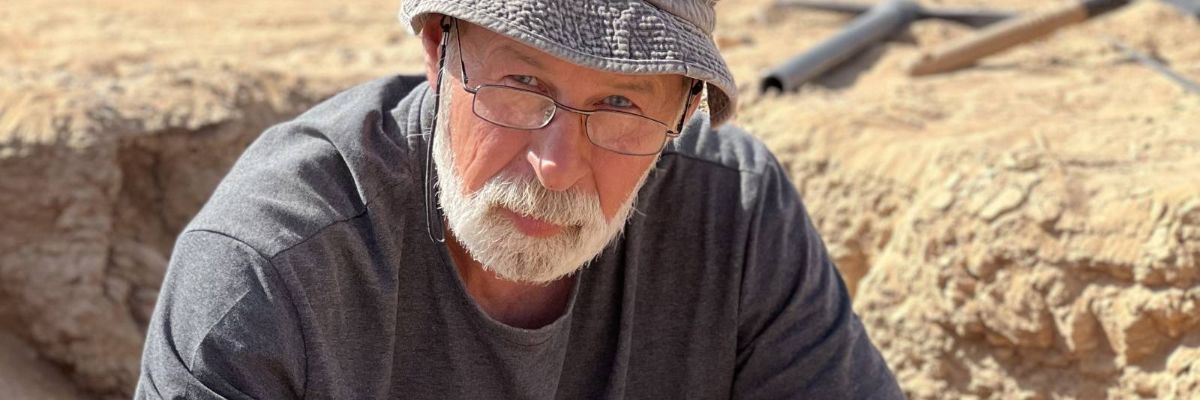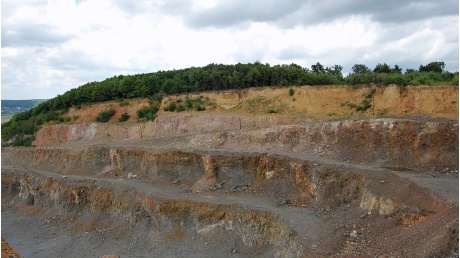
Involved in groundbreaking research, Ukrainian archeologist now works at the CAS
11. 03. 2024
Not everyone is lucky enough to work on a discovery that is of a textbook-rewriting nature, altering the existing knowledge of human history. However, Vitaly Usyk, who co-authored a groundbreaking new study published in Nature, has succeeded. The experienced Ukrainian archaeologist is part of the international research team that has managed to securely date the stone tools found at an archaeological site near the town of Korolevo in Transcarpathia, Ukraine. Thanks to the Researchers at Risk Fellowship programme of the Czech Academy of Sciences (CAS), the scientist now works at the Institute of Archaeology of the CAS in Brno. How did he first become involved with the CAS and what other projects is he working on?
The results of four years of research show that the first humans arrived in Europe 1.4 million years ago, settling it 200–300 thousand years earlier than previous evidence has suggested. The findings, which 12 research institutions from around the world were involved in putting together, are published in Nature as “East-to-west human dispersal into Europe 1.4 million years ago”. The lead author of the study is Roman Garba from the Nuclear Physics Institute of the CAS and the Institute of Archaeology of the CAS, Prague.
Scientists from the Institute of Archaeology of the CAS in Brno, where Vitaly Usyk’s journey took him, also worked on the research project. “The global magnitude of this discovery reflects the important role our institute has played in Palaeolithic research for a long time,” says Balázs Komoróczy, the director of the institute. According to him, the success shows how significant it is to create and foster networks of exceptional experts and institutions both within the Czech Academy of Sciences and on an international level.
“We are glad that the Academy has been able to support researchers, one of which was involved in the outstanding research team that has just published its findings in Nature, who have been deprived not only of professional stability and security due to the Russian invasion of Ukraine. They have often also lost their homes and found their own lives in jeopardy,” Komoróczy adds. The Researchers at Risk Fellowship programme supported and funded more than 50 Ukrainian researchers immediately after the outbreak of war in Ukraine.
One of them is Vitaly Usyk, who was able to join the Research Centre for the Paleolithic and Paleoanthropology at the Institute of Archaeology of the CAS in Brno in 2022. However, as he explains in the interview below, he started working with the Academy earlier.
*
You have cooperated with the Institute of Archaeology of the CAS in Brno (ARUB) before. When did your involvement with the institute start and what specific research focus or project was it about?
My collaboration with the Czech Academy of Sciences (CAS) began in 2021 when a memorandum was signed between the Nuclear Physics Institute of the CAS and the Institute of Archaeology of the National Academy of Sciences of Ukraine for the purpose of TCN burial dating of the Lower Palaeolithic horizon at the Korolevo I site in Transcarpathia, western Ukraine. In order to further develop this project, it was planned to carry out scientific research on the Palaeolithic sites of Transcarpathia, into which, in addition to other CAS institutes, the Institute of Archaeology Brno (ARUB) as a leader of Palaeolithic archaeology in the Czech Republic was included. These plans were interrupted due to Russia's full-scale invasion of Ukraine.

The archaeological site Korolevo I (Gostry Verkh) in 2007.
More than ten institutions from around the world were involved in this important discovery at the Korolevo site. How significant was this event for the Ukrainian party involved?
It is an extremely important event for the Ukrainian scientific society. For the first time, a new method of dating (cosmogenic burial dating) was used to determine the age of the most ancient archaeological artefacts from Korolevo, which was previously impossible by other methods.
Thanks, first of all, to the enthusiasm and perseverance of Dr. R. Garba as well as the participation of the Nuclear Physics Institute of the CAS and other scientists around the world in this research, it became possible to significantly increase the age of the appearance of the first humans in Ukraine and Europe as a whole.
Was ARUB an obvious choice for you after you left Ukraine following the Russian invasion?
Leaving Ukraine was not my choice and my decision. It was an emergency evacuation from Irpin city, Ukraine. I did not know about the fellowship programme until I arrived in the Czech Republic in March 2022. However, my relationships with colleagues from ARUB and the quality of the Palaeolithic research conducted here were naturally important for me to take advantage of this opportunity.
In 2022, thanks to the Researchers at Risk Fellowship programme, I received a position at the Institute of Archaeology of the CAS, Brno (ARUB). This allowed me to take part in preparing the study just published in Nature (Human presence in western Ukraine 1.4-million-years-ago favours east-west dispersal into Europe and to publish the results of the radiocarbon dating of the Korolevo II site with the participation of Dr. R. Garba. The research was supported by the Ministry of Education, Youth and Sports of the Czech Republic as part of the RAMSES project.
What was your journey to ARUB and the whole process like?
My journey to ARUB was smooth and quick. I have full access to Palaeolithic collections and library and the possibility to work safely in this department in collaboration with CAS scientists. I had the opportunity to take part in the excavations of the famous Palaeolithic site Dolní Věstonice I, as well as to continue working on articles submitted for CAS projects.
Which projects are you working on specifically?
I am working on preparing materials for articles based on the results of Palaeolithic research in the Sultanate of Oman (ARDUQ project of the Czech Academy of Sciences, Team Lead Dr. R. Garba). I plan to represent the Ukrainian part in the submitted ERC Synergy Grant EvoCOSMO (Unravelling the Human Journey to Europe: Investigating Evolutionary Timelines through Cosmogenic Nuclides), which could provide funding for the research in 2025–2031 (fieldwork in Oman, Ukraine, Czechia, Jordan, and Africa). This grant will place the Institute of Archaeology of the CAS, Brno, as an ERC project partner in a world-class research team on human evolution. In 2024, I plan to prepare the manuscript of a monograph titled Korolevo II site. Transition from Middle to Upper Paleolithic in Transcarpathia. Ukraine.
Is your collaboration with your original home institute at the National Academy of Sciences of Ukraine still ongoing?
Yes. I am working on preparing joint publications of archaeological materials obtained as a result of previous excavations of our institute. For example, three joint presentations were presented at Mikulov Anthropology Meeting III (MAM 2023) in September 2023.
You have stayed on after the fellowship programme has ended; are you joining the second round of the call?
At the moment it is difficult to answer this question. Maybe yes, if the war in Ukraine will not be over by that time.
*
For more details about the research findings at Korolevo, read our article "The first human presence in Europe securely dated to 1.4 million years ago" and our press release.
Prepared by: Zuzana Dupalová, External Relations Division, CAO of the CAS
Translated by: Tereza Novická, External Relations Division, CAO of the CAS
Photo: Vitaly Usyk
 The text is released for use under the Creative Commons licence.
The text is released for use under the Creative Commons licence.
Read also
- The beauty of Antarctic algae: What can diatoms tell us about climate change?
- Moss as a predator? Photogenic Science reveals the beauty and humor in research
- How does the Academy Council plan to strengthen the Academy’s role? Part 2
- How does the Academy Council plan to strengthen the Academy’s role? Part 1
- Ombudsperson Dana Plavcová: We all play a role in creating a safe workplace
- ERC Consolidator Grant heads to the CAS for “wildlife on the move” project
- A little-known chapter of history: Czechoslovaks who fought in the Wehrmacht
- Twenty years of EURAXESS: Supporting researchers in motion
- Researching scent: Cleopatra’s legacy, Egyptian rituals, and ancient heritage
- The secret of termites: Long-lived social insects that live in advanced colonies
The Czech Academy of Sciences (the CAS)
The mission of the CAS
The primary mission of the CAS is to conduct research in a broad spectrum of natural, technical and social sciences as well as humanities. This research aims to advance progress of scientific knowledge at the international level, considering, however, the specific needs of the Czech society and the national culture.
President of the CAS
Prof. Eva Zažímalová has started her second term of office in May 2021. She is a respected scientist, and a Professor of Plant Anatomy and Physiology.
She is also a part of GCSA of the EU.